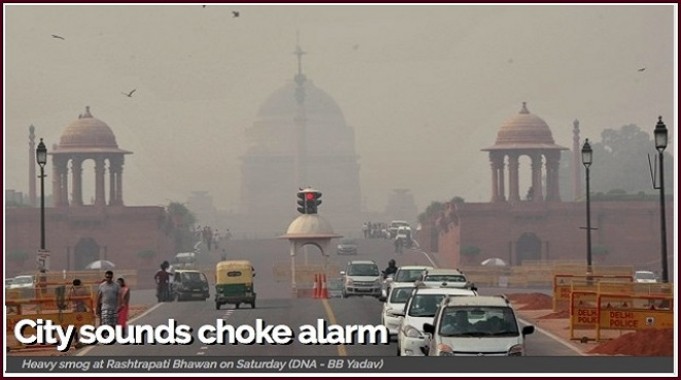Rising to the pollution challenge
October 30, DNA Delhi Edition.
As Delhi visibly fogs up in the wake of Diwali, the quality of coverage of city pollution also needs to comes into focus. How much do citizens need to know about what they are up against, and how to equip themselves? And about which civil body to turn the pressure up on and how, and what they themselves might be doing to make things worse?
Are reporters asking why the Delhi government did not do a special drive in the run up to Diwali day, issue any kind of alerts, mount a public service advertising campaign, with dos and don’ts? Were cracker sales curtailed? How should you both save the environment and protect livelihoods?
If Indian cities have a massive pollution problem staring them in the face which won’t go away any time soon, are the newsrooms in these cities doing enough to assess what role they need to play? Both climate change as a larger issue and city pollution as a local one can be broken up into segmented components that require specialized reporting, even as they require a segmented response from civic authorities.
Getting serious about climate change reporting calls for a multi faceted response from the newsroom. How are newspapers and websites in Delhi responding? Mostly, there are focused on reporting air quality monitoring at this point.
The Delhi edition of Daily News and Analysis which announced its arrival in the capital city earlier this month, is a good place to begin, because its consistent focus on the environment sets it apart. DNA likes to splice itself up into theme pages, and has a daily environment page. But if you look there for pollution-related coverage you are not going to find it. Over the last week air quality has become a dominant theme on its local city pages, with some spillover into the pages on health.
First, this paper has been devoting a lot of space to the issue. Its Sunday report (Oct 30) “City sounds choke alarm” gave 2/3rds of a page to explaining the air quality index, its health implications and told you which localities had reached a hazardous PM 2.5 level. But then others are doing this too. The Indian Express’s web edition on October 31 put out a fair amount of detail on how different parts of Delhi were turning toxic, also comparative data for other cities which put some parts of Ahmedabad on par with the worst of Delhi.
But what sort of coverage can you do beyond giving the alarmist particulate matter readings? Offer global pollution control measure comparisons, for one. DNA did that on October 24 but in a tiny box, which told us that civic agencies in other parts of the world put out no-burn alerts when the atmospheric pollution turns hazardous. Last Friday and Saturday the paper looked at the technical solutions for fighting air pollution which the city government is planning to deploy.
But this is basically what all city reporters are not going beyond, at this point.
Is the media here anywhere close to making environment the backdrop issue for any coverage it does? The state of the planet certainly merits it. Again DNA shows the way on some days. It has had reports on how coal mining increases poverty, and on the ways in which infrastructure creation such as road building is being modified to accommodate animal habitats.
And in terms of the depredations of cultural practice on the habitat, there are ghastly stories in DNA about owls being sacrificed during Diwali for a ritual, and monitor lizards being slaughtered because of demand for their blood as a booster for virility.
But if urban air pollution is a critical climate issue how many media outlets in Indian cities are deploying dedicated beat reporters for it? If there are a range of affordable technologies, investment strategies and policy options that municipalities can choose from “to significantly reduce short-lived climate pollutants” more journalists could begin by boning up on these so that they can ask the right questions.
To take just one website like ‘The Conversation’, which draws on both journalists and academia for its content,Its environment and energy coverage breaks up into the following sub topics: climate change, coral bleaching, nuclear energy, sustainable development, the Paris agreement, and oceans.
And its reporting on the crisis of pollution breaks up into carbon emissions, carbon dioxide, carbon price, carbon tax, coal, greenhouse gases, and renewable energy. Its writers monitor power stations in their countries to see if the most emission intensive ones have closed down, they scrutinize mine leases to see what conditions have been agreed to, they look at the issue of a carbon price for gas which competes with coal, the issue of a carbon tax, and much else.
But for the same breadth and depth of coverage to become the norm in India, editors need to decide that covering climate change and its local triggers is as important as politics or business, and worth investing talent in. Surely it is a more vital issue for millions than the fortunes of either Akhilesh Yadav or Cyrus Mistry?
